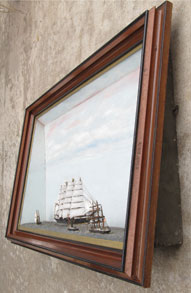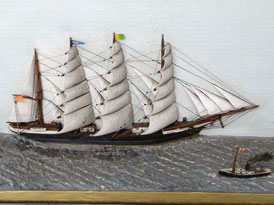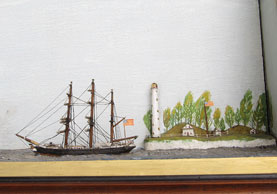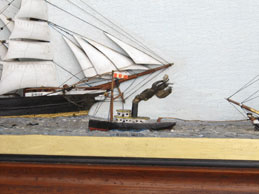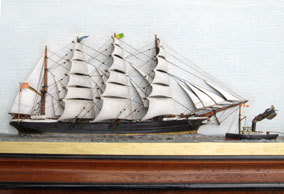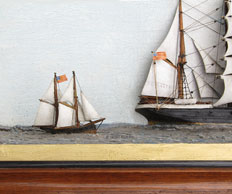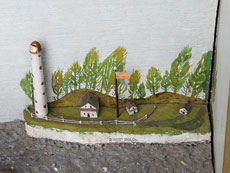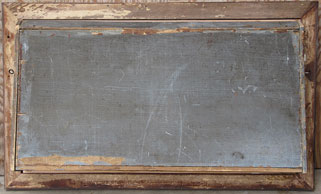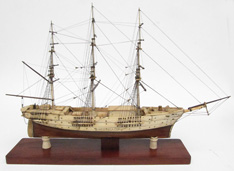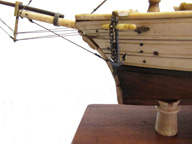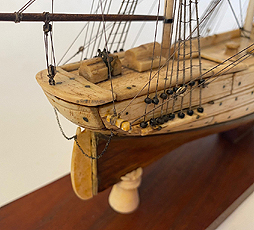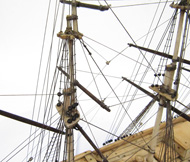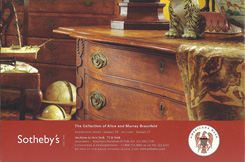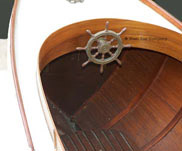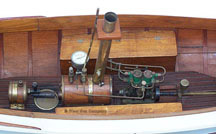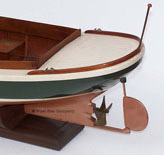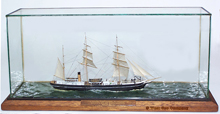West Sea
Company
MODELS & HALF
HULLS
Catalog Page 2

When no price is shown, use  button to request the price.
button to request the price.
Click on photos for larger images.
Click
 for ordering details.
for ordering details.

|
|
2.32 FOLK ART MODEL. Absolutely
charming late 19th century American cased waterline folk art
ship model. This delightful little wooden model
depicts a 2-masted schooner under full sail plying a
carved wooden sea with full-rigged
carved wooden sails! The
solid hull ship has a black boot topping and white bulwarks
with bowsprit, masts and yards in natural wood. The 3
jib sails are realistically portrayed with their attachment
to the standing rigging, and the mains’l and mizzen
are realistically attached with mast hoops! Ratlines
and hand-carved wooden blocks complete the rigging, which
must surely have been done by a sailor intimately familiar
with such details. But that’s not all. The
deck detail is amazing! Both old fashioned anchors
with chain are depicted. There are 2 deck houses with
cut-out windows and open doors. The helmsman is
standing aft at the helm with the poop deck above. Two
lifeboats in their davits are rigged, and they even contain
oars! Yet the piece-de-resistance of this model is the
depiction of no fewer than 14 crewmen going about their work
on the planked deck! The American flag flies atop the
mizzen. All surfaces of the model are colorful and
bright in their original old finish. This is because
the model has been housed in its original wooden case with
alligatored surfaces and old wavy glass on 5 sides.
The case measures 18 inches long by 9 inches wide and 14
inches tall. The model itself is 14 ¼ inches long
by 11 inches high. Condition is outstanding and
original in all respects. In the proper folk art
auction this model would zoom. Price just reduced from
1995!
995 
|

|

|

|

|
|
SHIP
|
CLOSE UP
|
FOCSLE
|
STERN CLOSE UP
|

|

|
|
2.33 TANK MODEL. Extremely
scarce late 19th century working model of a U.S. Navy fast
torpedo boat. This model is much rarer than an
equivalent builder’s half hull model. The sleek
hull was used to design and test the seaworthiness and speed
of such a vessel before building. It consists of a
laminated hull, similar in the construction to a half
hull, made in several pine “lifts,” then
hollowed out, with double bilge keels on both sides and an
applied laminated deck. It features a pointed
reverse shear bow with classic cruiser stern. A hole
is provided in the deck abaft amidships for attachment to
the monitoring equipment. This scarce example measures
31 ½ inches long by 3 3/8 inches wide. It is in
good original condition retaining its original unfinished
natural wood surfaces which have acquired a nice age
patina. There are the expected minor scuffs and dings
with one early repair to the stem is in evidence.
Otherwise the hull is quite sound and very
presentable. Well over 100 years old. The first
model of its type we have ever encountered.
395
With the advent of steam propulsion navies of the world were
intent upon producing two types of warships -- those with
armor and large guns, and those with speed and
agility. The fast torpedo boat, developed in the 1870’s
and refined through the end of the century, exemplified the
second type of vessel. The torpedo boat was a
relatively small, fast vessel designed to carry torpedoes
into battle. The first designs rammed enemy ships with
explosive spar torpedoes while later designs launched
self-propelled torpedoes. They were created to
counter battleships and other large, slow moving armored
ships relying on their speed and maneuverability. The
tactic was that a number of smaller fast boats could
overwhelm a large slow moving ship armed with big,
manually-operated guns. Accordingly, a fleet of
torpedo boats could engage much larger and more expensive
ships. The drawback was that the smaller vessels were
confined to coastal waters because of size and limited
fuel.
The introduction of fast torpedo boats in the late 19th
century was a major innovation in naval warfare of the era.
In response, navies operating large ships introduced
smaller ships to counter the threat. These were essentially
the same as the torpedo boats they faced, but mounted a
light gun instead of torpedoes. As these designs
evolved they became known as "torpedo boat destroyers,"
eventually evolving into the modern destroyer.
An example of such a boat, the USS FARRAGUT,
Torpedo Boat No. 11 (BT-11) was launched by the Union
Iron Works of San Francisco on July 16, 1898, just a few
days too late to participate in the Spanish American
War. She was 219 feet long and displaced 279
tons. However, by the time she was commissioned in
March of 1899 such vessels had already become outmoded as a
naval tactic. This was evidenced by the fact that
FARRAGUT was used as a training ship during World
War I until her decommissioning on March 19, 1919.
|
|
|
|
|
|
BOW DETAIL
|
MIDSHIPS DETAIL
|
STERN
|

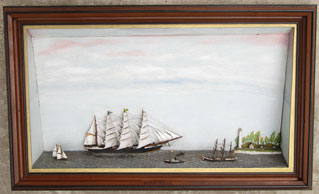
|
|
2.36 SHIP DIORAMA. Absolutely
delightful 19th century American sailor folk art diorama
depicting a charming coastal scene with 3 sailing ships and
a tugboat. The foremost vessel is a 4-masted
American bark identified on the starboard trail board and
the mizzen pennant as the “DIRIGO.” She is
depicted under full billowing sail, all of which are made
from carved wood! She is
outfitted with a carved wooden female figurehead, a capstan
on the focs’le, anchor on the cat, 2 deck houses, a
lifeboat in davits and even a skylight on the poop.
All lines are in tact rigged with carved wooden
blocks. Aft of the DIRIGO is a small 2-masted
schooner under sail, also flying the American ensign.
Forward of the DIRIGO, passing to starboard, is a
steam tug towing another American bark out to sea. The
tug billows dark (cotton) smoke as it pulls the bark with no
sails into a head wind. This smaller 3-masted bark is
also very nicely executed with carved figurehead, good deck
detail and all lines present. Filling out the
scene is a prominent lighthouse on a spit of land. It
towers over 3 adjacent buildings surrounded by a white fence
and trees in the background. Yet another American flag
is depicted flying from a tall flagpole capped by
pearl. Ingeniously, a luminescent “light”
made of mother-of-pearl adorns the lantern of the
lighthouse. All vessels are of carved wood and ply a
painted putty sea. The large background panel is made
from a single piece of pine, nicely painted with subtle
colors portraying the sky in a realistic manner.
Evidencing its age, the paint has become slightly
alligatored with time. The sides of the diorama are
also pine affixed with old nails and wood screws. The
back is painted in its original dark blue/gray paint with
evidence of old newspaper used to seal the joints. The
entire presentation is nicely framed in a period “Eastlake”
style walnut frame with gold liner and retains it original
old wavy glass. It measures 24 ½ by 40 ½
inches overall and 18 ½ by 34 ½ inches
sight. The diorama is constructed on a slant, tapering
from 7 inches thick at the bottom to 4 inches at the
top. A magnificently preserved example of this
desirable form of sailor folk art. Circa
1890. 
The 4-masted Bark DIRIGO was homeported in the Pacific
Northwest in the gold4en age of the lumber trade there, also
coinciding with the Alaskan gold rush. Further
research could reveal additional information about the time
and place of this scene.
|
|
|
|
|
|
PERSPECTIVE 1
|
PERSPECTIVE 2
|
DETAIL 1
|
|
|
|
|
|
DETAIL 2
|
DETAIL 3
|
DETAIL 4
|

|
2.35 SCARCE WEST COAST HALF
HULL. Genuine builder’s half block
model used in the actual construction of the representative
vessel. This fine example is constructed in the traditional
way using at least 7 laminate “lifts” of what
appears to be Western Red Cedar. The vessel depicted
is a motor trawler of 1930’s vintage. The model
is in its original varnished finish with a lovely mellow
patina. Two of the lifts are stained to represent the
waterline and freeboard. A very handsome original half
hull which measures 26 ¼ inches long, 4 ¼ inches
wide and 4 ½ inches high. This model retains its
two original eyelets for convenient display. Excellent
original condition throughout with a great old look!
Very reasonably priced. 
The fact that this model is constructed of cedar, indigenous
to the state of Washington, indicates it was made by one of
the shipbuilding yards that flourished in that region at the
turn of the last century.
|

|
|
2.31 UNUSUAL FOLK ART SHIP
MODEL. Charming 19th century sailor-made ship
model of a 3-masted bark. This folksy little model is
well-executed showing cat heads, anchors, capstan, running
lights and chocks on the focs’le. The main deck
has 3 hatches, 2 deck houses, lifeboats and 4 sets of
bits. The poop deck exhibits another hatch, skylight,
steering gear with helm and two more sets of bits.
Standing rigging is depicted in a realistic manner and the
yards are squared. This waterline model has red boot
topping, green bulwarks and a black deck. It is
inset into a nicely finished natural pine plank cut-out to
receive the hull. The periphery of this mount is
surrounded by macraméd cotton line which extends
upward on the 4 corners to a “bell rope” hanger
at the top with two Turk’s head knots. Finishing
off the decorative ropework, two star knots are affixed to
the plank. The model itself measures 13 ½ inches
long, 5 inches wide and 9 ¼ inches tall. The
mount is 15 inches wide, 5 3/4 inches deep and hangs 20
inches tall overall. There is a wooden “spreader”
just below the “bell rope” hanger which keeps
the entire assembly nicely in place. Excellent
original condition. The first such configuration of a
ship model we have encountered! 975

|

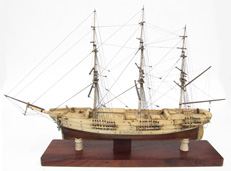
|
|
2.30 AMERICAN SCRIMSHAW MODEL.
Rare! Genuine
3rd quarter of the 19th century sailor-made scrimshaw model
of a 3-masted packet ship. This well-rigged, highly
detailed model is scrimshaw. It is
NOT a beef bone P.O.W model!
Constructed of whalebone, whale ivory, baleen and a rich
tropical hardwood, the keel and bottom of the ship are dark
brown wood. The boot topping is a narrow strip of
black baleen attached with tiny pins. Above it, from
the bulwark to the rail is planked whalebone attached with
brass pins. Deck fittings are carved of bone and ivory
including the bowsprit, figurehead, catheads, foc’sle
capstan, bilge pump, main deckhouse, cargo holds, ladders,
aft deckhouse with bench, skylight, binnacle and steering
gear box with brass helm. The detail is really quite amazing
given the material from which it is made. The masts
and tops are all of carved whalebone as are the
meticulously-fashioned bone blocks in the running
rigging. The spars are all of dark hardwood which
provide a very pleasing contrasty effect. The
ratlines and stays on each mast are hand-tied and terminate
in “bead” dead eyes along the bone-braced
bulwarks. This model is in superb original condition
mounted on its original African mahogany stand. It
measures14 inches long overall by 10 inches tall and is 4
¾ inches wide on the mainmast spar. A
superlative, museum-quality example of American whaleman
scrimshaw art at its finest , proudly exhibiting its 140+
year age.  
A nearly identical model was sold from the very
prestigious collection of Alice and Murray Braunfeld at
Sotheby’s American Furniture and Folk Art sale
conducted January 17, 2004 during “Americana Week.”
Not available or for sale in
California. Shipped from Massachusetts.
|
|
|
|
|
|
|
REVERSE
|
FIGUREHEAD
|
FORWARD DETAIL
|
AFT DETAIL
|


|
|
2.10 LIVE STEAM MODEL.
Impressive, large mid-1900’s launch featuring a
genuine live steam propulsion plant. This high quality
model is likely of German manufacture. It has a sleek
molded fiberglass hull fully sheathed and planked on the
inside with mahogany and teak. The inner floor boards
are of planked mahogany to which the steam plant is
mounted. It consists of a gas burner sheathed in wood
with brass banding. The burner exhausts into the
boiler, similarly sheathed, containing the throttle, relief
valve, pressure gauge and tall smokestack. Attached to
the front of the smokestack is a working brass steam
whistle. The steam outlet is directed to the dual
reciprocating engine with crankshaft and revering
gear. Abaft the crankshaft is a heavy flywheel
connected to a universal joint, grease cup and the drive
shaft. The shaft extends through the rear of the
vessel terminating in a 4-bladed brass propeller.
There are 2 compartmental seats with hinged lids on either
side of the engine and another small double door compartment
in the forward peak. This model is complete with brass
helm wheel and large pivoting rudder. The foc’sle
has a brass stockless anchor with chain and a large wooden
bitt. The deck is trimmed in mahogany with 2 brass
chocks and a flagpole aft. The model rests in its
heavy solid mahogany stand measuring 30 ½ inches long
by 5 ¼ inches wide. The launch itself measures 50
inches long with a beam of 13 ½ inches. The
entire presentation stands 17 inches tall. We have not
attempted to fire up the steam plant. But be assured,
every aspect of the engine is clean and free of
corrosion. The crankshaft readily turns and all
components of the drive train move freely.  
|
|

|
|
2.28 MINIATURE MUSEUM
MODEL. Genuine hand-made model of the early
20th century San Francisco Bay ferryboat “MENDICINO”
operated by the Western Pacific Railroad, as stenciled on
both sides. This wonderfully detailed waterline model is
constructed entirely of wood with hand-cut brass and metal
fittings. It comes from the prestigious collection of the
DeYoung Museum of San Francisco, California which was
recently sold by that institution to generate funds for
expansion and improvements of their facility. The model
itself measures 6 1/4 inches long by 1 1/2 inches wide. With
that, it exhibits superb detailing for a model of its size
and type. It is signed on the bottom in pencil,
"NorthWestern Redwood Empire Ferry MENDICINO." Excellent
condition with all original old painted surfaces. A
great early San Francisco Bay offering! 595
This exquisite little model is of the Northwestern Pacific's
premier ferryboat MENDICINO built by Bethlehem Steel
Company, Union Yard, San Francisco in 1927. She had a steel
hull with a length of 251 feet, breadth of 46 feet, 19 foot
draft and displaced 2,467 tons. Later in her career
her ownership was transferred to the Southern Pacific
Railroad and finally to Golden Gate Ferries, Ltd. The
identity of the modeler who constructed this fine ship model
is unknown, but obviously he was in every sense a skilled
professional!
Literature: George E. Harlan, “San Francisco Bay
Ferryboats,” 1967, Howell-North Books, Berkeley,
California, page 178.
|
|

|

|
|
REVERSE
|
SIGNATURE
|
2.17 DOCKYARD MODEL. Genuine,
mid-1900’s dockyard model identified on the presentation
plaque, “MODERN OIL TANKER S.S. T.S. PETERSON Launched April
11, 1950 Length Over-All 624’-9-3/4… Normal Crew 50 men,
OPERATED BY CALIFORNIA TRANSPORT CORPORATION (Subsidiary of Standard
Oil Company of California).” This authentic builder’s
model is hand-made to scale (1 inch = 16 feet) with the most exacting
of tolerances and detail. The hull is of solid wood and all
deck fittings are of wood or metal. It is depicted from the
waterline up in a fully loaded condition plying a calm sea,
represented by a painted wooden base. It is contained within
its heavy plate glass case on a mahogany base. The model itself
measures 38 ½ inches long, 5 ¼ inches wide and 6 ½
inches high. The case measures 43 ¾ inches long, 9 ¾
inches long and 9 ¼ inches high. Outstanding original
condition, noting only some very minor age crazing to the paint along
parts of the stern. Surely this model adorned the corporate
offices of the California Transport Corp. in its early days.


Representative of America's post-war building program, the 29,680
gross register ton tanker T. S. PETERSON, was laid down
at the Sparrows Point, Maryland yard of Bethlehem Steel Corporation
in 1949 and launched on April 11, 1950. In 1958 she changed
house flags under ownership of the Chevron Shipping Company and was
renamed the CHEVRON TRANSPORTER. Under that name
she continued to operate until 1976 when she was scrapped in Taiwan
after being replaced by a new series of ships with their
superstructures aft.

|

|

|
|
NAME PLATE
|
IN CASE
|
BOW DETAIL
|

2.03 FAMOUS BATTLESHIP MODEL with MUSEUM
PROVENANCE. Exhibition-quality model of the World War II
dreadnought USS CALIFORNIA (BB-44). This sailor-built model is
faithful to the original ship and was actually built on board during
one of the most famous Naval battles in history, the Battle of the
Surigao Straits on October 25, 1944! The large wooden stand bears the
engraved Bakelite plaque reading: "MODEL OF THE USS CALIFORNIA
Hull turrets and guns are of balsa wood, superstructures are of white
pine, gun shields and platforms are of bristol board. Model took 10
months to complete. This model has been through the battle of Surigao
Straights in the Philippines. It was there when Mac Arthur landed on
Leyte Island in the Philippines. Built by B. M. Mickschl CH
CARP. USN." The hull measures 38 inches long by 7 inches wide
and the model stands 10 1/2 inches high overall. The stout wooden
base measures 41 inches long by 8 3/4 inches wide. Now complete with
a professionaly-made custom Plexiglass case. This model is in an
incredible state of original preservation considering its
construction, detail and age. A genuine piece of history!
2495
A well-known Museum has commissioned us to
sell this model, because it is not in keeping with the Museum's
collection objectives. For purposes of public anonymity we will not
publish the Museum's name here. However we will provide provenance to
the successful buyer so that this valuable aspect of the model's
history will not be lost.
The USS CALIFORNIA (BB- 44) was a
Tennessee-class battleship launched on November 20, 1919 by Mare
Island Navy Yard, California and was commissioned on August 10, 1921,
as flagship of Pacific Fleet -- a duty she retained until 1941. She
took part in the Presidential reviews of 1927, 1930, and 1934 and was
modernized in 1929-1930.
On "The Day of Infamy," December 7, 1941,
she was moored at the southernmost berth of "Battleship Row" in Pearl
Harbor, Hawaii. At 0805 a bomb exploded below decks in an ammunition
magazine killing 50 men and setting her afire. A second bomb ruptured
her bow plates. Despite valiant efforts to keep her afloat,
CALIFORNIA settled into the mud with only her superstructure
above the surface. When the action ended, 98 of her crew were lost
and 61 wounded. On March 26, 1942 she was refloated and departed
under her own power for Puget Sound Navy Yard for major
reconstruction.
Restored to her original glory,
CALIFORNIA sailed from Bremerton on January 31, 1944 in time
to provide shore bombardment for the invasion of the Marianas
Islands. During the bitter fight for Saipan in June, she was
conducting shore bombardment when struck by an enemy shore battery
killing one man and injuring nine. Following Saipan, her heavy guns
helped blast the way during the assaults on Guam and
Tinian.
In September 1944 CALIFORNIA prepared
for the invasion of the Philippines. From October 17 through November
20 she played a key role in the Leyte operation, including
participation in the last classic Naval battle ever fought between
surface combatants, the Battle of Surigao Strait on October 20th.
That momentous engagement resulted in the decimation of the Japanese
fleet. On January 6, 1945 while providing shore bombardment at
Lingayen Gulf she was hit by Kamikazes, killing 44 and wounding 155.
Again she departed the front to undergo repairs Stateside.
Returning to action at Okinawa in June 1945,
CALIFORNIA remained until July 21st. Two days later she joined
Task Force 95 to cover minesweeping operations in the China Sea.
After the surrender of Japan in early August, CALIFORNIA
sailed via Singapore, Colombo, and Capetown, to Philadelphia, with a
fitting arrival on December 7th. She was placed in reserve on August
7, 1946 and ultimately sold for scrap in 1959.
CALIFORNIA received seven battle
stars for World War II service. Today, her bell rests in a memorial
at Capital Park, Sacramento, a fitting tribute to a fine ship and her
crew.
SPECIFICATIONS
Length overall: 624' 6"
Beam: 114'(1943)
Mean Draft: 30' 5"
Displacement: 40,950 tons (1943)
Speed: 20 knots (1943)
Main guns: 12 14"/50 cal. (Mk 11), 4 triple turrets
Secondary: 10 x 5"/51 cal. mounted in sponsons
16 x 5"/38 cal. in 8 twin turrets (1945)
56 x 40mm Bofors in fourteen quad mounts
6 x 50 cal. heavy machine guns
80 x 20mm Oerlikons
2 x 21" Torpedoes
Complement: 57 officers, 1026 men

|

|

|

|

|
|
PERSPECTIVE
|
STERN
|
AMIDSHIPS
|
BOW
|
PLAQUE
|

|

|

|
|
IN 1936
|
PEARL HARBOR
|
IN 1944
|

2.96 MUSEUM MODEL & PHOTO.
Genuine hand-made model of an early 20th century San Francisco Bay
ferryboat operated by the Western Pacific Railroad, as identified on
the bottom with pencil markings. This wonderfully detailed waterline
model is constructed entirely of wood with hand-cut brass and metal
fittings. It comes from the prestigious collection of the DeYoung
Museum of San Francisco, California which was recently sold by that
institution to generate funds for expansion and improvements of their
facility. The model itself measures 4 1/2 inches long by 1 1/2 inches
wide. With that, it exhibits superb detailing for a model of its size
and type. It is signed on the bottom in pencil, "Wes. Pac. RR
Co. Ferry, San Francisco." Excellent condition with all original old
painted surfaces. Accompanying this offering is a rare period
photograph of the actual vessel circa 1915, mounted on its original
card which measures 8 by 10 inches and is in
perfect original condition. A great
early San Francisco Bay offering!
495
This exquisite little model is identifiable as the Western
Pacific's premier ferryboat EDWARD T. JEFFERY built by Moore
& Scott Iron Works, Oakland, California in 1913. She had a steel
hull which displaced 1578 tons, with a length of 218 feet, breadth of
42 feet and a 16 foot draft. The JEFFERY was a very
well known ferry, highly esteemed by Bay residents at that
time. Later in her career, about 1930, she was renamed
FEATHER RIVER. In 1933 she was again renamed SIERRA
NEVADA when ownership was transferred to the Southern Pacific
Railroad. The identity of the modeler who constructed this fine
ship model is unknown, but obviously he was in every sense a skilled
professional !

|
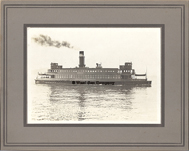
|

|
|
REVERSE
|
PHOTO
|
SUPER DETAIL
|

2.20 MUSEUM QUALITY MODEL. Absolutely
superb, professionally-built scale model
identified on the painted wooden presentation plaque on the front of
the case,“The Whaler DISCOVERY as converted for SCOTT’S
POLAR EXPLORATION Scale 32’ = 1”.” This
exquisite miniature waterline model depicts all aspects of the
handsome ship’s details in a scale so fine as to defy
imagination! The carved wooden hull is gracefully
contoured. The wooden masts and spars are as fine as
needles! Rigging is faithful and to scale. The deck
equipment, ladders, wheels, lights, funnels, anchors, bitts,
lifeboats and more are of amazing quality. In short this
Lilliputian model portrays a real ship in a miniature size. It
is housed in its original all glass case with realistic putty sea and
a shaped mahogany base. The model itself measures a mere 7
inches long overall by 4 inches high. The case measures 13
inches long by 4 ½ inches wide and 6 inches high.
Outstanding original condition with good signs of age.


Provenance: Parker Gallery, London, 1967.
DISCOVERY was laid down by The Dundee Shipbuilders
Company on March 16, 1900 in Dundee, Scotland. She was launched
on March 21,1901, christened by Lady Markham, wife of the President
of the Royal Geographic Society. Displacing 1,570 tons, with a
length 172 feet in length and a beam of 33 feet, the 3-masted steam
whaler was of wooden construction. Her compliment was 11 officers and
36 men. Bark-rigged, DISCOVERY had coal-fired
auxiliary steam engines which provided a maximum speed of 8
knots. But the she was designed primarily for sail. Her
especially stout wooden hull was built to withstand being frozen in
ice. DISCOVERY was the last 3-masted wooden sailing
ship built in Britain.
Five months after setting sail on August 6, 1901 from the Isle of
Wight, the crew of DISCOVERY first sighted the Antarctic
coastline on January 8th the following year. During that first month
Scott charted the coastline. In preparation for the winter, he
anchored in McMurdo Sound, where the ship would remain frozen in the
ice pack for the next two years. During that time the
expedition was able to determine that Antarctica was indeed a
continent, and they were able to relocate the Southern Magnetic
Pole. Using explosives, the ship was finally freed on February
16, 1904 and sailed back to Britain, arriving on September 10,
1904.
The British National Antarctic Expedition was acclaimed upon its
return. But the Society was in serious financial trouble.
DISCOVERY was sold to the Hudson’s Bay Company in
1905, employed as a cargo vessel between London and Canada until the
First World War. Outdated and outclassed by more modern
merchant vessels, she was laid up in 1920.
But in 1923 DISCOVERY’s fortune changed when she
was revived for further research work in the Antarctic. Registered to
Stanley in the Falklands and designated as a Royal Research Ship,
DISCOVERY underwent a major refit before sailing in October
1925 for the South Seas to chart the migration patterns of whales and
to do other Antarctic research. She continued in that duty
through 1931.
Her research days over, DISCOVERY was again laid up until
1936 when she was presented to the Boy Scouts as a stationary
training ship. During the Second World War her engines and boilers
were removed for scrap to help with the war effort. Too costly for
the Scouts Association to maintain, she was transferred to the
Admiralty in 1955 for use as a drill ship for the Royal Navy
Reserves. As the years passed her condition deteriorated.
Being of no further use to the Navy, she was earmarked for
scrapping. Thankfully though, she was saved from the breakers
by the Maritime Trust in 1979, which assured her final rest in Dundee
Harbor, Scotland, where she reamins to this day.
Robert Falcon Scott was a Royal Navy officer and
explorer who led two expeditions to the Antarctic. The first
was the Discovery Expedition (1901-1904) and the second was the
ill-fated Terra Nova Expedition (1910–13). In his second
quest, Scott led a party of five which reached the South Pole on
January 17, 1912, only to find that they had been preceded by
Norwegian Roald Amundsen. Defeated and exhausted, tragically Scott
and his four comrades succumbed to hunger and the extreme cold on
their return from the Pole.

|

|

|

|
|
MIDSHIP DETAIL
|
BOW DETAIL
|
SHIP
|
STERN DETAIL
|

|
|
PHOTO
|

2.14 CRUISE MEMENTO MODEL.
Genuine passenger ship cruise trophy from the famous
American President Lines cargo/passenger liner the "S. S. PRESIDENT
CLEVELAND" as identified in embossed letters below the model of the
ship. This good likeness is formed of heavy cast metal done with
faithful detail. It is faced by an engraved brass plaque reading “ACHIEVEMENT”
and flanked by the embossed inscription “ACHIEVEMENT.”
Excellent overall condition with a good age patina. 8 1/2 inches long
by 2 1/2 inches wide. A very displayable and handsome authentic
model. 69
The steam cargo/passenger ship SS
PRESIDENT CLEVLAND was a P2 design ship built in 1947 by
Bethlehem Shipbuilding Co., Alameda California, Hull No. 9509.
She had a length of 609 feet, a draft of 30 feet, displaced 23,404
tons and had a cruising speed of 20 knots. Designed to carry
379 First Class passengers and 200 economy, she also boasted a cargo
capacity of 193,984 cubic feet. Homeported in San Francisco,
the CLEVELAND along with her sister ship the PRESIDENT
WILSON reestablished America’s preeminence in the
passenger trade between the West Coast and the Orient. But in
1973, with passenger liner service no longer profitable, American
President Lines sold the ship. It was scrapped a year
later.

|
|
BACK
|

2.11 CASED MODEL. Simply superb folk
art model of an American 4-masted bark identified on the
quarterboards as the "DELFIN." This scratch-built sailor-made
model is constructed entirely of wood with some metal parts such as
davits and rails and exhibits the highest standards of the ship
modeler's art. All deck details are represented including chocks,
bitts, running lights, capstan, ventilators, ladders, rails, deck
house with skylight, doors and windows; ship's boats in davits,
midships deckhouse with Charlie Noble, hatches, fife rails, poop with
deck house, steering gear box, binnacle and a finely executed
railing. Detail aloft is also of the highest order showing the
standing rigging taught and to scale with blocks properly depicted.
The vessel flies the American ensign from the spanker boom aft and is
identified on the stern transom "DELFIN BOSTON." The ship is shown
standing at anchor with both hooks out in a painted putty sea. The
entire presentation is contained within its original glazed wooden
case in untouched original condition showing great old crackled
surfaces. The model itself is crisp, bright and as clean as they
come. The case measures 19 3/4 inches long by 6 1/2 inches wide and
stands 10 1/4 inches high. One of the nicest folk art ship models
ever! 


|

|

|

|

|

|
|
PERSPECTIVE
|
SHIP
|
FOC'SLE
|
MIDSHIPS
|
POOP
|
STERNBOARD
|

2.07 FAMOUS SHIP MODEL. Exceptional,
working model of Admiral Byrd's first Polar exploration ship the
USS CITY OF NEW YORK. This period, hand-made model is of all
wood construction with brass, metal, mica and even some ivory
fittings! The solid hull is laminated in lifts, similar to the
construction of authentic half hulls. It is painted black below the
waterline, gray on the bulwarks, with white rails. There are five
portholes aft and 3 gunports amidships on each side. The vessel is of
full ship rig with three masts and has authentically detailed
standing and running rigging, fife rails, belaying pins, rat lines,
dead eyes, mast tops, etc. The focsle deck is complete with capstan,
cat heads, kedge anchors and chain life lines. Amidships are the life
boats in their davits, cargo hatch and winch. Further aft the deck
house is complete with portholes, door and windows with mica "glass."
A water cask with spigot is mounted on top along with the Marconi
antenna and flying bridge with functional helm! There is also a
footed storage box, dinghy and racks of ivory buckets
with bail handles! On the poop deck is the skylight with mica
windows. Mounted atop it is the binnacle which actually shows the
compass needle! On the starboard side is a sounding machine. The
after steering gear is incredible. It is realistically constructed
with chains fairlead through pulleys, connected to the flying bridge
helm, which actually turn the rudder! To accomplish this, the rudder
is attached with functional post and pintle construction. Forward of
the rudder is the ship's brass propeller. The model is supported in a
solid teak wood cradle and is protected within a lovely solid glazed
mahogany case. The model itself measures 34 1/2 inches long overall
and 23 inches high. The case measures 41 inches long, 11 1/2 inches
wide and stands 27 1/2 inches tall. This model is authentic to the
period and may have actually been constructed by a crewman onboard
the CITY OF NEW YORK. Circa 1930. Excellent original condition
throughout showing good age and careful preservation.

THE SHIP
The famous polar exploration ship USS
CITY OF NEW YORK was originally built as a sealing barkentine
named the SAMPSON, launched in Arendal, Norway in 1885. Of
very stout construction, her hull was up to 34 inches thick in some
places! Lingering stories suggest that she was the "mystery ship"
seen on the night RMS TITANIC sank. Many witnesses claimed to
have seen lights of an unknown ship near TITANIC that fateful
night. SAMPSON purportedly was engaged in illegal sealing
operations at the time and location TITANIC went down. The belief is
that the crew of SAMPSON was startled by the fast approaching ship
firing rockets. Thinking it to be a revenue cutter, the poachers
fled. In tragic irony, it was actually the ill-fated TITANIC
firing distress rockets after it had struck an iceberg!
After a long career as a sealer,
SAMPSON was purchased in 1927 for the U.S. Navy by Admiral
Richard E. Byrd to be used as his polar exploration flagship. En
route New York for refit she was nearly lost in a severe storm
crossing the Atlantic. With her steam engine inoperable, the transit
ended up taking 3 months instead of 3 weeks! But finally she arrived
in her new namesake port where she was rebuilt and ship-rigged as the
CITY OF NEW YORK.
Newly fitted out, the USS CITY OF NEW
YORK departed New York on August 25, 1928 bound for New Zealand.
Arriving there on November 26th, she took on additional supplies and
set out for Antarctica. Upon reaching
the pack ice on January 1st 1929, CITY OF NEW YORK located a
suitable spot for an Antarctic base. The newly established base was
named Little America, where it actively remains to this day! After
CITY OF NEW YORK unloaded her cargo she attempted exploration
trips through the ice. But in the face of severe weather, the ship
was forced to abandon such attempts. She departed for New Zealand in
mid-February, barely making it out of the ice pack in time. After
refueling from a supply ship she pushed north through terrific gales
and was nearly lost. She laid up for the winter in New Zealand.
Undaunted, CITY OF NEW YORK sailed south on January 5, 1930.
But again, she ran into heavy weather from the start, and only
reached pack ice after great difficulty. There she was hit by a 100
mph hour gale. With her engine straining, she was driven backwards
onto the ice shelf. To save her rudder the captain swung her
broadside and she rode out the gale pinned to the ice. The storm
encased the CITY OF NEW YORK in over 200 tons of dangerous ice
topside. With a normal displacement of only 500 tons, tired crewmen
were forced to set about the laborious task of chipping away the ice
for fear of capsizing! CITY OF NEW YORK finally arrived at
Little America on February 18th. Evacuation of personnel still at the
base commenced immediately, and within 24 hours the ship was headed
north again.
Upon returning to her homeport, CITY OF
NEW YORK was replaced on future Antarctic explorations by the
famous ex-whaler, the USS BEAR. CITY OF NEW YORK became a
floating polar research museum, touring the Atlantic coast and Great
Lakes. World War II brought great need for shipping. To help meet
that need CITY OF NEW YORK was rerigged as a 3-masted
schooner, stripped of her engine and reentered service in 1944 out of
Halifax, Nova Scotia. But by 1947 she was deemed to be too slow. So
her topmasts were removed, her bowsprit was shortened and she was
fitted with an engine. Thus she became a motor schooner, carrying
lightened sail.
The venerable ship finally met her fate in
1962 when, as she was being towed out of Yarmouth Harbor, Nova
Scotia, the tow line parted and she drifted onto Chebogue Ledge. She
quickly took on water and sank.
THE MODEL
Norwegian Martin Rønne was a veteran
of famous Roald Amundsen's 1911 expedition which was the first to
reach the South Pole. Employed as a tent and sail maker, Rønne
quickly established a reputation as a gifted craftsman and hard
worker. Several years later, in 1926, American Polar explorer Richard
Byrd asked Amundsen who he would recommend as an advisor for his
forthcoming Antarctic expedition. Without hesitation Amundsen named
Martin Rønne.
It took 3 years and a considreable sum for
Byrd to convince Rønne to join the party. But Rønne
finally relelented and embarked on the expedtion which arrived at the
southern continent in early 1929. Months later, Rønne wintered
over at Little America with 42 other men. He was the only man in the
group who had ever been to the Antarctic before, including Byrd
himself! During those long winter months Rønne completed
sledging equipment, tents, sleeping bags, and clothing for coming
summer explorations. In his spare time he also made a model of their
flagship, the CITY OF NEW YORK, which he presented to Byrd the
following year. In 1933, this model was exhibited onboard the ship
itself at the Century of Progress exhibition in Chicago. At the time
Byrd, was offered three thousand dollars for it but rejected the sum.
Byrd valued Rønne's work and often exhibited the model with
great pride, expressing his admiration in the most glowing
terms.
Martin Rønne and Richard Byrd were
good friends. In later years Byrd wrote of him in his book, "Little
America," “. . . the oldest and most experienced man in the
party was Martin Rønne, a 68 year old Norwegian veteran of
several of Amundsen's expeditions. It was a silken tent he made, left
behind by Amundsen, that Scott found at the South Pole. I now
understand why Amundsen recommended him. I doubt if I will ever come
across another man like Rønne where work is concerned. He is
probably the greatest craftsman in polar clothing to be found
anywhere.”
http://ronneantarcticexplorers.com/Martin_Ronne.htm
Written provenance that this is
Rønne's model does not exist. But certainly its age, the
precise execution of its details, consistent with one intimately
familiar with the ship itself, and the materials from which it is
made, all point to the fact that IT IS!
(See also item 5.25 EXTREMELY IMPORTANT
HISTORICAL COLLECTION "USS BEAR.")

|

|
|
IN CASE
|
REVERSE
|

|

|

|

|

|
|
AFT
|
DECK
HOUSE
|
FOC'SLE
|
STERN
|
FIGUREHEAD
|

2.08 FAMOUS SHIP MODEL with MUSEUM
PROVENANCE. Period, hand-made model of the World War II troop
ship USS HERMITAGE. This sailor-made model exhibits excellent
craftsmanship and very fine detail, with all aspects of the ship's
construction meticulously executed, even down to the coxswain's rails
and planking on the ship's boats! The large, solid hull wooden model
measures 41 inches long by 5 1/4 inches wide at the widest on the
bridge wings. It is mounted atop its original solid cherrywood base
measuring 43 inches long by 5 1/2 inches wide and 1 inch thick.
Outstanding original condition for a model of this size, construction
and vintage! 2495
A well-known Museum has commissioned us to
sell this model because it is not in keeping with the purpose of its
collection. The Museum has asked us to provide anonymity during this
offering. However full Museum provenance will be provided to the
successful buyer so that its valuable history will be retained with
the model.
The grand passenger ship S.S. CONTE
BIANCOMANO was launched in 1925 by William Beardmore & Co.
Ltd. of Glasgow, Scotland, sailing as a luxury liner for Lloyd
Triestino So. Anon. di Nav. Italia. When Italy declared war on the
United States shortly after America's entry into the War with Japan
in December 1941, CONTE BIANCOMANO was interned at Balboa,
Canal Zone, sailed to the U.S. and converted to a troop transport by
Cramp Shipbuilding of Philadelphia. She was commissioned as the
USS HERMITAGE on August 14, 1942.
On November 2, 1942 HERMITAGE
embarked 5,600 army troops and sailors and departed New York for the
Mediterranean. Six days later the North African invasion began, and
HERMITAGE debarked her passengers at Casablanca to participate
in the famous campaign known as Operation Torch. Returning to
Norfolk, Virginia on December 11th, HERMITAGE next steamed for
the Pacific with nearly 6,000 passengers embarked. After embarking
and debarking passengers at Balboa, Noumea, Brisbane, Sydney Pago
Pago, and Honolulu the former luxury liner put into San Francisco on
March 2nd, 1943.
HERMITAGE next made way for
Wellington, New Zealand on March 27, 1943, calling at Melbourne,
Australia and Bombay India. In Bombay she embarked some 707 Polish
refugees, including nearly one hundred children, for a voyage back to
California which ended on June 25th. In the following year
HERMITAGE made three similar cruises in the South Pacific,
with battle-bound troops, civilians, and refugees.
HERMITAGE departed New York on June
16, 1944 with over 6,000 troops headed for the D-Day invasion of
Europe, which had just begun at Normandy. From then on, until the end
of the war, she made 10 more voyages to Le Havre and other ports,
bringing additional troops to the European theater and returning the
wounded back to the States along with P.O.W.'s.
V-E Day, May 8, 1945, found HERMITAGE
in the midst of a celebration in Le Havre Harbor, France. With the
War over, she was pressed into service returning veterans home from
the European theater through December 1945. Departing New York 12
December, the well-traveled transport sailed to Nagoya, Japan to
embark 6,000 veterans to Seattle, arriving February 4, 1946. Assigned
to the San Francisco-Marianas run for Operation Magic Carpet, she
made three more voyages before being decommissioned in San Francisco
on August 20, 1946.
While serving with the Navy,
HERMITAGE sailed over 230,000 miles, transporting 129,695
passengers, including American, British, Australian, French and Dutch
fighting men. She also carried Chinese, American, Polish, and British
civilians, not to mention German and Italian prisoners.
HERMITAGE was returned to the Italian Government in May 1947
and renamed SS CONTE BIANCAMANO once more. Fittingly, the
sunset of her career saw her continuing in her originally designed
role as a passenger liner until she was ultimately scrapped in
1969.

2.70 CASED FOLK ART MODEL.
Exceptional late 19th century American sailor-made model of the
4-masted bark signed on the stern in relief "DIL" (probably
the maker's initials) and identified on both trail boards as
"ALBERT." This charming folk art ship model is entirely hand made in
a manner very faithful to the original. The sleek, waterline hull is
sculpted entirely out of carved wood. All aspects of this model are
executed with a superiority of detail that we have never encountered
in such a model before. ALL of the ship's lines, both
standing and running rigging are depicted, including the square sail
lift lines, bunt lines and clews, and even individually hand tied rat
lines. These are details rarely seen even on the finest scale
models. Also depicted are the jib sail halyards -- virtually
never seen in a model of this type. All tackle (blocks) are
individually formed and properly depicted with line actually rove
through the cheeks. Other rigging details include chafing gear on the
ratlines and even tiny keeper stays tied between them! Fine woolding
is in evidence at the attachment of the aft spanker sail. Deck
detailing is superior. All 4 hand-carved lifeboats are meticulously
depicted in their cradles. The deck detail on this fine model include
wooden ship's rails; ladders; deck houses with windows, doors and
decorative carving; portholes; the "Charlie Noble"; kedge anchor and
anchor davit; capstan; ship's foc'sle bell; hatches; bits; catwalk
with railing, steering gear box with wheel; binnacle; port and
starboard running lamps; and even deck scuppers! In short, the maker
of this model knew every inch of his ship and was determined to get
it right no matter how much effort it took!! All the more remarkable
is the fact that this beautifully rigged vessel is depicted with a
full compliment of carved wooden sails elegantly
sculpted in a billowy and realistic manner. To have depicted it with
paper or cloth sails would have been a chore enough -- but in
wood?! This simply incredible model is housed within
its original hand-made wooden case with its original old wavy glass
measuring 32 3/4 inches long, 17 1/4 inches high and 9 3/4 inches
wide. The model itself measures 24 inches long and 14 inches high. It
plies a realistically formed blue putty "sea" with curling waves and
painted white caps. This model flies a colorful house flag, large
name pennant and the American ensign aft. This is without a doubt the
nicest sailor-made model we have ever seen. Outstanding, untouched,
original condition. A joy to behold! Retail $4500.
3500

Provenance: San Francisco Bay area
estate.
The handsome square
rigger ALBERT was launched by the Hall Brothers Shipbuilding
Yard, Port Ludlow, Washington in 1890. She was of bark rig with a
length of 182 feet and displaced 682 tons. Home ported in San
Francisco, she plied the West coast trade until being wrecked near
Point Reyes, California on April 2, 1919.
The 3 flags on this model corroborate its
dating and origin. The house flag "P" for Port Ludlow, the name
pennant "A" for Albert, and the 40 star American flag which only
existed for a few months during the year 1890.
The provenance of this model is also
consistent with its home port and the locale of its ultimate demise
-- the rugged outcropping on the Marin coast known as Point Reyes,
just north of San Francisco.

|

|

|

|
|
FOCSLE DETAIL
|
RIGGING DETAIL
|
RIGGING DETAIL AFT
|
STERN DETAIL
|

2.67 DETAILED STEAM/SAIL SHIP MODEL.
Really superb scratch-built and dated American model of
a steam/sail brig from the 19th century. This period model is
entirely hand made with precision detail and near scale rigging. The
laminated wooden hull is beautifully sculpted and has a hollow
interior with keel, tween deck, and lead ballast. The wooden deck in
old mustard paint is scored to simulate planking. Details include
bowsprit with dolphin striker and chain stays; billet head; both
kedge anchors; rotating foc'sle capstan; fife rails; main deck hatch
with accommodation ladder; removable deck house with funnel; steam
whistle; "Charlie Noble"; 2 ventilators; 2 lifeboats; ship's bell;
deck ladder; doors; windows with glass; aft house with door and
glazed windows; functional helm; poop deck ladders; helm bell; poop
deck skylight and realistic brass eagle sternboard! But there is much
more! The deck house is signed on the bottom "Built 1876 to 1882."
Using extreme care it may be safely removed to reveal an internal
gearing system attached by a leather belt to an arbor running through
the port side bulwark. Engaging the arbor with a clock winding key
actually rotates the vessel's propeller! When the deck house is in
place, the funnel is secured by 4 removable guy wires. As mentioned,
the helm is functional and works as a real ship's steering station of
the period. The helm is fitted with a wooden spindle attached to the
steering gear. Turning the wheel to the left or right actuates the
rudder in the appropriate direction! If the realism of this
presentation were not enough, the entire model is mounted to a
beautifully constructed dockyard cradle complete with hull supports
making for a realistic stand. This exceptional model measures 40 1/2
inches long overall by 13 1/2 inches wide at the mains'l yard and 29
inches tall. Condition is nothing short of perfect. All
surfaces retain their original old paint. The fine, realistic rigging
appears to be original and is in a sound, outstanding state of
preservation. A nicer folk art model of its type is not to be found!



|

|

|

|
|
DETAIL
|
STERN
|
HELM
|
BOW DETAIL
|
|

|

|

|

|
|
MECHANISM
|
ARBORHOLE
|
DOCKYARD
DETAIL
|
DATE
|
|

2.19 DOCKYARD MODEL. Authentic
mid-19th C. cased shipyard builder's half hull model of the 3-masted
sailing ship VERBENA built by "Wm Pickersgill & Sons,
Sunderland," England as identified in hand-painted lettering below
the bow. This exceptional model exhibits all of the detail and
quality expected of an "owner's model" as built by the shipyard that
produced the actual ship. Fine, fancy original glazed hardwood case
measuring 85 inches long, 17 1/2 inches high and 9 inches deep
overall. The model itself measures 70 1/2 inches long from stern to
bowsprit. Circa 1856. Immaculate condition throughout. Certainly
worthy of the finest museum! 

"Lloyd's Register of Shipping" Volume 1871
lists the VERBENA as a wooden hull bark of 260 feet in length,
displacing 466 tons net. She was built in Sunderland in 1856 and
operated by J. Whitfield of Sunderland.
In a publication entitled "Sunderland Builds
Ships," 1989, Tyne and Wear Archive Service, City of Sunderland,
England, William Pickersgill is identified as one of the prominent
Wearside (River Wear) shipbuilding firms from 1847-1936.

|

|

|
|
FOC'SLE
|
LIFEBOAT
|
BOW DETAIL
|

|

|
|
STATISTICS
|
SIGNATURE
|

2.99 CASED MODEL. Charming, really
nice sailor folk art model of the famous battleship U.S.S.
TEXAS as prominently engraved on the large brass name plate and
on both sides of the vessel's bow. This near scale, solid hull wooden
model is entirely hand made from wood and brass with many
intricate details not typically found on such models. For example all
of the lifelines are made of drilled brass rods. The gun barrels are
tapered and drilled brass. The scores of portholes depicted in the
hull are drilled and rimmed with brass. All of the other fittings and
the superstructure itself are either carved wood or hand-worked
brass! This model is in its original battleship gray paint with black
boot topping. The paint has alligatored with age and now exhibits a
great old surface. The wooden decks in natural finish have also
acquired a rich age patina. The ship itself measures 35 1/2 inches
long by 14 inches high and 6 1/2 inches wide at the widest. It is
mounted on its original solid mahogany display stand in original
black paint with cloth bottom and measures 38 inches long by 9 inches
wide. The stand is overlaid by the glazed oak case which measures 40
1/2 inches long by 16 1/2 inches high and 11 1/4 inches wide.
Excellent overall condition. 

The USS TEXAS (BB-35) was the second
battleship to bear the state's name and the second New York class
battleship to be built. Laid down on April 17, 1911 by the Newport
News Shipbuilding & Drydock Co. in Virginia, she was launched on
May 18, 1912 and commissioned on March 12, 1914. She was one of only
a few capital ships to serve in both World Wars.
Immediately after her commissioning
TEXAS was dispatched by President Wilson to deal with a
conflict in Mexico. Finally, in December, she left Mexican waters to
join the Atlantic Fleet.
The use of unrestricted submarine warfare by
the Central Powers in the Atlantic dragged America into the war in
Europe in 1917. TEXAS served in the Grand Fleet by providing
convoy escorts to troopships as well as helping the British to
blockade the enemy in the North Sea.
Following overhaul in late 1918 TEXAS
resumed duty with the Atlantic Fleet. On March 9, 1919 she became the
first American ship to launch an airplane.
Early in 1925 TEXAS entered the
Norfolk Navy Yard for "modernization" to replace her cage masts with
a single tripod foremast and to upgrade her gunfire control
system.
In the intervening years leading up to World
War II TEXAS saw duty in the the Pacific and Atlantic
theaters, serving as the flagship of the entire United States Navy
Fleet.
Upon America's entry into World War II
TEXAS saw her first combat in "Operation Torch" during the
invasion of North Africa in 1942 by providing shore bombardment and
naval gunfire support.
Throughout 1943 and into 1944 the veteran
battleship carried out her familiar role as a convoy
escort.
On the morning of
June 6, 1944 TEXAS provided shore bombardment prior to the
D-Day assault on the coast of Normandy, France.
On the morning of June 25 TEXAS, in
company with the Battleship ARKANSAS, began shelling shore
fortifications and batteries surrounding the German-held port of
Cherbourg. In the exchange TEXAS lost her navigation bridge
and the forward fire control tower with one man killed and several
wounded.
After undergoing temporary repairs in
Plymouth, England TEXAS again entered the fray, this time to
engage shore batteries in the pre-landing assault of St. Tropez,
France. That mission completed, she departed 2 days later for her
home port of New York.
Upon arrival TEXAS underwent a major
overhaul which included replacement of the barrels in her main
batteries.
TEXAS departed New York in November
1944 bound for the Pacific theater via the Panama Canal. She arrived
off of Iwo Jima on February 16, 1945 where she spent the next two
weeks in a gunfire support role during that infamous battle.
Next she steamed into Philippine waters where
she spent nearly 2 months providing gunfire support for various
Allied landings. During that time she endured many Kamikaze attacks,
recording one kill and three assists. TEXAS stayed in the
Philippines until the Japanese surrender on August 15th. She received
5 battle stars for her World War II service.
TEXAS was decommissioned on April
28,1948 as she was turned over to the state of Texas as a permanent
memorial. Today she remains in San Jacinto State Park, near
Houston.
The fact that this model depicts
TEXAS with her post-1925 tripod mast, but with her
side-mounted 5 inches guns (removed prior to 1930) clearly indicates
that the model dates to 1925, certainly no later than
1930!

|

|

|
|
IN CASE
|
REVERSE
|
U.S.S. TEXAS
|

|

|

|

|
|
FORWARD
|
AMIDSHIPS
|
AFT
|
STERN
|

© 1998-2014 West Sea Co. All
rights reserved.
![]() for ordering details.
for ordering details.
















